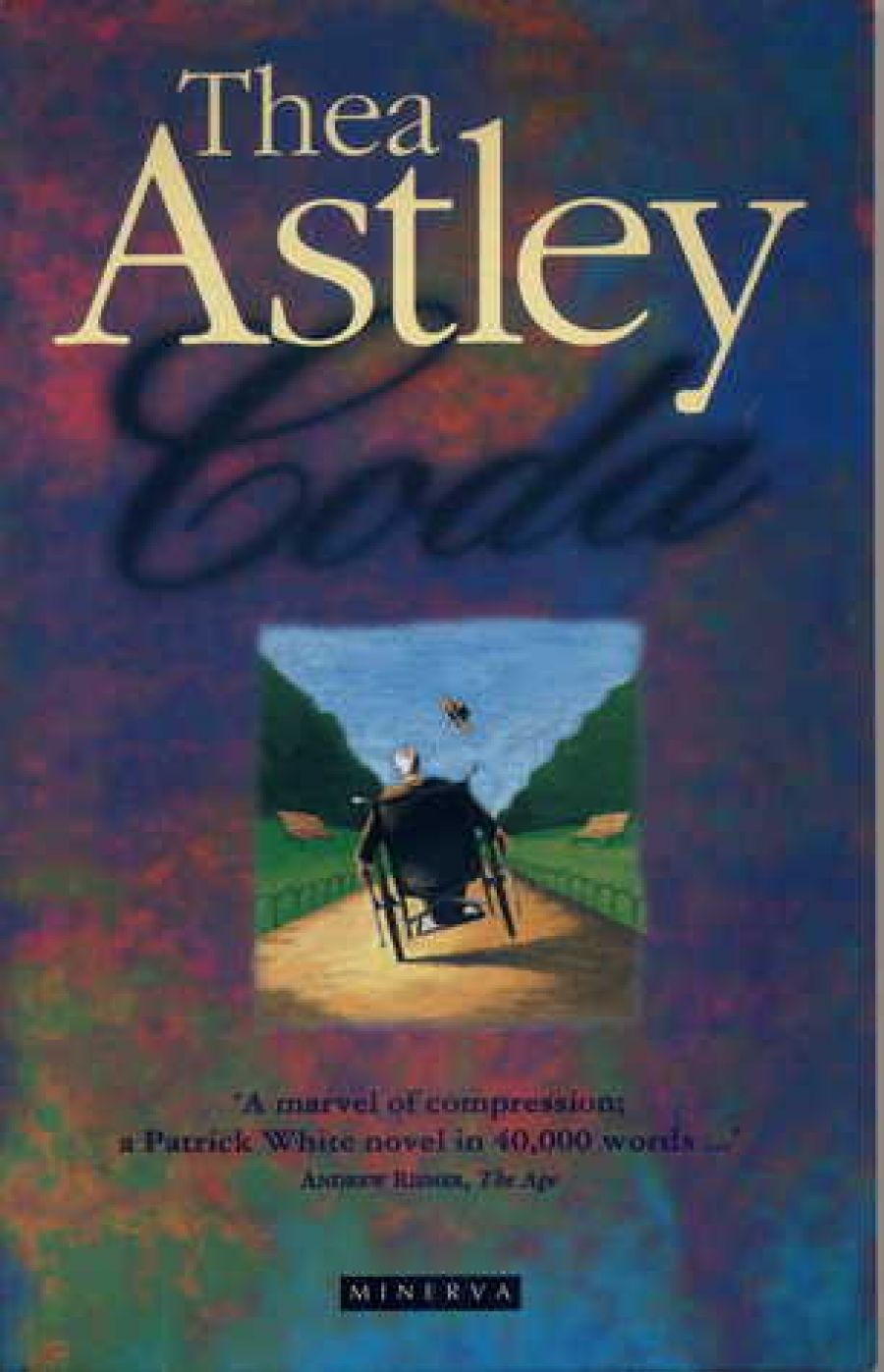
- Free Article: No
- Contents Category: Fiction
- Review Article: Yes
- Online Only: No
- Custom Highlight Text:
Each of the three parts that make up Thea Astley’s new novel, Coda, is prefaced by a newspaper report, real or imaginary, detailing cases of ‘granny-dumping’, the ruthless abandonment of old, frail, and disoriented people by their unidentified children. This sets the scene for a reflection on old age and the rejection of those whose physical and mental capacities no longer meet the stringent requirements of the standard economically viable unit of modem civilisation. The manifest duty of such objects is to be as discreet as possible, providing minimal inconvenience to others (especially their adult children) until they can fade into oblivion.
- Book 1 Title: Coda
- Book 1 Biblio: W.H. Allen, $24.95 hb
- Book 1 Readings Link: booktopia.kh4ffx.net/VJ34R
But the indignities of old age are not the only focus of this complex novel. It is also about the desire to somehow escape from the mediocre drudgery of everyday life, the yearning for some scarcely defined impossibility. On a bridge in Venice, Kathleen’s son Brian succumbs to the overwhelming urge to launch into a full-blooded operatic rendition of Tosti’s last song. He also constructs a huge statue dubbed ‘The Big Developer’ on a piece of land he owns on the Queensland coast – a statue bearing an outrageous similarity to his politician brother-in-law. His father’s attempts at escape are more tragic: a mysterious and pointless essay into the jungles of the island where he runs his store to carve his name on a rock on a high mountain, then return to Brisbane, silence and a lonely death from cancer. Futile and unproductive, yet madly glorious moments of freedom.
The combination of islands, voyages, and seafaring men in Coda reminds me irresistibly of Marguerite Duras’s 1987 novel, Emily L. In both novels, islands become simultaneously haven and prison, symbols of some impossible goal which eludes the searcher even as it is reached. The demands of marriage and relationship crush the fragile autonomy of the dreamer taking with them any chance of unfettered love. Emily L. and her husband the Captain live bathed in an infinite despair which fills all the available space in its suffocating tragedy. The inhabitants of Coda in their bleakest hours can merely aspire to the obscure comedy of ordinary people. No romantic and dark history here – simply the attrition of the everyday, the slavery imposed by the never-ending round of financial obligation, bodily decline, and a vague and disquieting longing. Kathleen, her husband, and her son Brian, unlike Emily L. and her captain, simply do not have the money to oscillate endlessly between those agonising islands.
Comparison of the two novels is also interesting at another level; it highlights some of the differences between the Australian and European vision. There is little to laugh at in the story of Emily L. or in the novels of that other extraordinary European observer of the interior cancer of solitude, Peter Handke. But for Astley the refined pretensions of a certain urban culture embodied in the persons of Kathleen’s daughter and daughter-in-law are a constant target for the ironic deflation of the practical.
Contemporary European civilisation has rendered itself all but impervious to such distractions. In Astley’s vision, even the most profound sense of social isolation never means isolation from the ever-invasive physical environment – the dripping humidity of Brisbane weather, the wild proliferation of plants and insects. Practical considerations always threaten to creep in unawares, insinuating themselves even into the highest pinnacle of urban refinement – relentless rainforest vines slowly crumbling the outer walls of the city’s defences.
It is also worth comparing Astley’s work with two other Australian novels on feminine old age and physical decay: Dorothy Hewett’s The Toucher (1993) and Jessica Anderson’s Tirra Lirra by the River (1978). Where Hewett’s novel flies off into contrived and overblown gothic excess and Anderson’s sinks into dreariness, Coda generally manages to hit just the right note except unfortunately in one notable instance. This is the moment when Kathleen’s daughter takes her to the retirement village, precisely the point at which the writing needs to be strongest. The irony and ambiguity which make the rest of the novel so attractive suddenly dwindle to a disappointingly flat surface.
Once out of the retirement village, however, the sparkle returns, leaving the reader rather puzzled at this anomaly. Such minor criticisms aside, however, Coda is an eminently energetic and evocative novel, satisfyingly complex in the range of its ruminations: ‘There’s more to this story’, as one character says. ‘It will be pointillist. A spot here. A dab there. As it comes. Hang in there!’


Comments powered by CComment